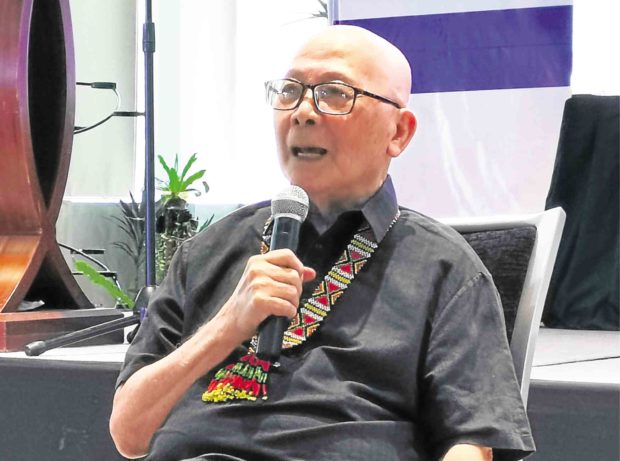
Pampanga again staked its reputation as the culinary capital of the Philippines during the Namnamin festival organized by the National Committee on Literary Arts (NCLA) of the National Commission for Arts and Culture (NCCA).
The festival of writers and cuisines was NCLA’s contribution to Buwan ng Panitikan, the national celebration of Philippine letters every April spearheaded by the NCCA.
The festival consisted of plenary talks, panel discussions, cooking demonstrations and of course, meals and meals and meals.
Writers and chefs shared tales and recipes from far-flung places so unique they satiated the hungriest minds. There were singers, dancers, poets, rappers and two National Artists for Literature—Bienvenido Lumbera from Batangas and Resil Mojares from Cebu, writer-scholars who offered their respective take on cuisine and culture.
Timely
Lumbera said the festival’s focus on regional cuisine was timely and Pampanga, with its acclaimed cuisine, should provide a fitting backdrop for
the conference. “Magandang pagkakataon ito upang pagtuunang pansin ang pagkain ng mga rehiyon at ang Pampanga ay isang nangunguna pagdating sa pagkain,” he said.
“Food writing has become popular in the past few decades,” Mojares said. “It’s not just eating but an education in itself.”
Quoting Doreen Gamboa Fernandez from an interview by Barbara Gimblett, writer, cook and book designer Ige Ramos said: To be considered Filipino, culinary practices did not need be Filipino by origin. Nor did they need to preserve some original or authentic form. Quite the contrary. Filipino is as Filipino does. The question is not “What is Filipino food?” but “How does food become Filipino?”
Filipino cuisine is undergoing a major revolution, Ramos said. Even chefs and writers such as Andrew Zimmern and the late Anthony Bourdain have praised it, he added. Zimmern was even quoted as saying “Filipino food is the next big thing.”
Food historian Felice Prudente Sta. Maria in her talk “Manifestations of Cultural History” said Philippine cuisine stays Filipino even when foreign ingredients are incorporated into Philippine preparations.
“Foreign preparations are ‘Filipinized’ as they become popular,” she said.
Monica Macansantos said every time she got asked what Filipino food tasted like, she would resort to the “convenience of comparison” by referring to its resemblance “to Chinese but not quite, it’s similar to Spanish food, and it has American influences, too.”
Sessions were as varied as turo-turo—from traditional palm starch extraction by John Bengan, Andrea Malaya Ragrario and Myfel Paluga, to symbolic representation of food in Cebuano poetry by Cindy Velasquez, diasporic representations of Filipino food by NCLA head Hope S. Yu, coffee and Cordillera cuisine by Kankanaey poet Gawani Domogo Gaongen, and food-drying technology in times of crisis by Gil Dulon.
But as expected, what forged the solidarity among the conference speakers and audiences were the communal dining experiences. Everyone had a common love for food.
The welcome dinner featured a variety of authentic Filipino dishes from Luzon, Visayas and Mindanao, prepared specifically for Namnamin by Robert Lo’s restaurant, Balanghai, in SM Telebastagan.
Kare-kare and sisig were served on day one. The last dish, which reportedly owed its origins to Pampanga, was served courtesy of Pampanga’s own Fresh Options Meatshop. Dinner was courtesy of Gov. Lilia Pineda.
Second day featured a talk by chef Claude Tayag as well as Atching Lillian Borromeo, who likewise made her famous Sanikulas (San Nicholas) cookies, which bore the image of the patron saint of bakers. During the dinner, courtesy this time of San Fernando Mayor Edwin Santiago, Lumbera and Mojares were presented by the city’s Vice Mayor Jimmy Lazatin with Pampanga-made lanterns.
Completing the culinary journey was a visit to Angeles City, where chef sau Del Rosario hosted lunch at his restaurant, 25 Seeds. Here, dishes by Culinaria Pampanga, an organization consisting of renowned Kapampangan chefs, were highlighted, such as Del Rosario’s sisig, humba by Manuela Cherry Pasion-Tan of Apag Marangle, asadong dila by Howard Dizon, kilayin by Ian and Elsa Joson of My Lola Nor’s Meryendahan, biringhe by Delyo and Linda of Delyn’s, and dessert by Susie’s Cuisine.
“The whole thing was like a fiesta,” said Juliet Mallari,
Namnamin festival director and NCLA executive committee member. “I’m also very happy representing Central Luzon.
We are very proud that we are able to showcase the good things about Pampanga.”—CONTRIBUTED